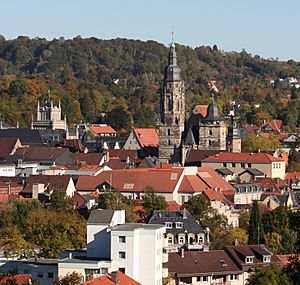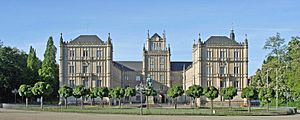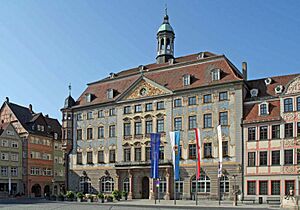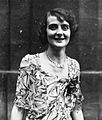Coburg facts for kids
Quick facts for kids
Coburg
|
||
|---|---|---|

View over Coburg
|
||
|
||
| Country | Germany | |
| State | Bavaria | |
| Admin. region | Oberfranken | |
| District | Urban district | |
| Elevation | 292 m (958 ft) | |
| Population
(2022-12-31)
|
||
| • Total | 41,842 | |
| Time zone | CET/CEST (UTC+1/+2) | |
| Postal codes |
96450
|
|
| Dialling codes | 09561 | |
| Vehicle registration | CO | |
| Website | www.coburg.de | |
Coburg is a historic town in Bavaria, Germany, located on the Itz River. In 2005, about 42,000 people lived there. Coburg became part of Bavaria in 1920 after a public vote. Before 1918, it was one of the two main cities of the united Duchy of Saxe-Coburg and Gotha.
Coburg's coat of arms shows Saint Maurice, who is the city's patron saint. This coat of arms was first given to the city in 1493.
Contents
Discovering Coburg's Past
Coburg is located about 90 kilometers (56 miles) south of Erfurt and 100 kilometers (62 miles) north of Nuremberg. The town was first mentioned in a document from 1056. However, there was a settlement called Trufalistat in this area even before that time.
After being owned by several noble families, Coburg came under the control of the House of Wettin in 1353. This happened when Friedrich III, also known as "the Strong," married Katherina von Henneberg. In 1596, Coburg became the capital of the new Duchy of Saxe-Coburg. Duke Johann Casimir led this duchy from 1596 to 1633.
Royal Connections and Visits
Because of many family connections between European royal families, Coburg was a popular place for royal weddings and visits. Britain's Queen Victoria visited Coburg six times during her 64 years as queen.
In 1896, a special ceremony in Coburg brought together many important royals. These included Queen Victoria, her son Edward (who would later become King Edward VII), and her second son Alfred (the Duke of Saxe-Coburg-Gotha). Her daughter, the German dowager Empress Friedrich, was also there. Many of her grandchildren attended too, such as Tsar Nicholas and Alexandra of Russia, Kaiser Wilhelm II of Germany, and the future King George V of Great Britain.
Coburg in Modern Times
In 1920, two years after the last duke stepped down, the people of Coburg voted to join Bavaria. This was an important decision. While other nearby areas later became part of East Germany after World War II, Coburg became part of West Germany.
Because of this, during the Cold War, Coburg was right next to the Iron Curtain. This meant it was surrounded by East German territory on three sides.
Exploring Coburg's Main Sights
Coburg has many interesting buildings and places. These show its history as a capital of small German states. You can find many houses from the 16th, 17th, and 18th centuries. Here are some of the most important landmarks:
- Ehrenburg: This was once a Franciscan convent built in 1220. It was turned into a castle between 1543 and 1549 and updated until the 19th century. The inside decorations are from the late 1600s and early 1700s.
- St.-Moriz Church ("St. Maurice", 14th-16th centuries): This is a Gothic church with two towers. The inside was redone in 1701. It has a famous monument for Duke John Casimir. This is a 12-meter-tall alabaster sculpture with statues and carvings, made between 1595 and 1598.
- The medieval Veste Coburg: This is one of the largest and most beautiful castles in Germany. It was mostly rebuilt in the 1800s. It has three layers of walls with many towers. Martin Luther stayed here in 1530. Today, the castle has three museums with old weapons, art, and other interesting exhibits.
- Casimirium: An elegant Renaissance building from 1598.
- Gymnasium Casimirianum: A school that started in 1601.
- Arsenal: Built between 1616 and 1621.
- Coburg State Theatre
- Coburg Doll Museum
- Callenberg Palace
- Town Hall: Built in 1414.
- Castle Rosenau: Located near Coburg.
- The Baroque sanctuary at the Basilica of the Vierzehnheiligen: About 20 kilometers (12 miles) outside the city.
Religions in Coburg
Most people in Coburg are members of the Evangelical Church, which is a Lutheran church. Other Christian groups include Baptists, Seventh-day Adventists, the ICF Movement, Jehovah's Witnesses, Catholics, Old Catholics, and the New Apostolic Church. There are also three Muslim communities.
Coburg had a large Jewish community until the 1940s. Jewish people have lived there since the 14th century. The old synagogue was once a church and is now used by Old Catholics. Coburg became Protestant after the Reformation. A new Catholic community was started in the 19th century.
Coburg's Districts
Coburg is divided into 15 different areas, or districts:
- Coburg City
- Beiersdorf
- Bertelsdorf
- Cortendorf
- Creidlitz
- Glend
- Ketschendorf
- Löbelstein
- Lützelbuch
- Neu- and Neershof
- Neuses
- Rögen
- Scheuerfeld
- Seidmansdorf
- Wüstenahorn
More than two-thirds of Coburg's population live in the main Coburg City district.
Famous People Connected to Coburg
Many famous people have connections to Coburg, including royalty and other notable individuals.
- In 1530, Martin Luther stayed in the Veste Coburg while important meetings were happening in Augsburg. He also gave sermons at St. Moriz church.
- In 1887, Johann Strauss II, known as the Waltz King, moved to Coburg. He lived there for the last 13 years of his life. Even though he lived in Coburg, he was buried in Vienna.
- Hans Morgenthau, who helped create the study of International Relations, was born here.
- The US National Hot Dog and Sausage Council says that the Frankfurter might have been created in the late 1600s by Johann Georghehner, a butcher from Coburg. This is a fun fact about the origin of hot dogs!
- Other famous people associated with Coburg include Hans Berger (who graduated here), William Frishmuth (born here), and Eduard Study (born here).
Sister Cities
Coburg has several sister cities around the world:
 Canada, Cobourg
Canada, Cobourg Italy, Gais
Italy, Gais USA, Garden City
USA, Garden City UK, Isle of Wight
UK, Isle of Wight France, Niort
France, Niort Belgium, Oudenaarde
Belgium, Oudenaarde
Images for kids
See also
 In Spanish: Coburgo para niños
In Spanish: Coburgo para niños














